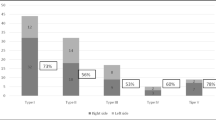Abstract
Postural deformities are frequent in neonates. The moulded baby syndrome (MBS) comprises one or more of the following disorders: plagiocephaly, torticollis, congenital scoliosis, pelvic obliquity, adduction contracture of a hip and/or malpositions of the knees or feet. We analysed the incidence of MBS in healthy neonates and identified the risk factors of its composing elements. One thousand and one healthy neonates were examined on the second or third day of life by the same paediatrician. Familial, obstetrical, perinatal history and putative risk factors for postural deformities were collected. Families of newborns with a torticollis or plagiocephaly were given positioning advice and the outcome was evaluated by a phone survey 2 months later. MBS was detected in 107 neonates (10.7%): 97 plagiocephalies or torticollis, 25 congenital scoliosis or pelvic obliquities, and 13 malpositions of the knees or feet. We identified risk factors related to the mother (age: OR = 1.39, parity: OR = 0.643), to the obstetrical history (preterm labour: OR = 1.65, oligoamnios: OR = 10.179, breech presentation: OR = 2.746, pregnancy toxaemia: OR = 3.773, instrumental delivery: OR = 6.028) and to the newborn (male gender: OR = 1.982, birth length: OR = 1.196). The initial plagiocephaly or torticollis improved in 77% of infants after 2 months of stimulation and positioning measures. Paediatricians should be alert regarding the frequent but subtle MBS postural deformities and give positioning advice to the parents. A neonate of male gender or greater birth length, with an older primiparous mother, a history of preterm labour, oligoamnios or pregnancy toxaemia, a breech presentation or an assisted delivery is more likely to have MBS.
Similar content being viewed by others
Abbreviations
- MBS:
-
Moulded baby syndrome
- OR:
-
Odds ratio
References
[No authors listed] (1992) American Academy of Pediatrics AAP Task Force on Infant Positioning and SIDS: Positioning and SIDS. Pediatrics 89:1120–1126
Boere-Boonekamp MM, van der Linden-Kuiper LT (2001) Positional preference: prevalence in infants and follow-up after two years. Pediatrics 107:339–343. doi:10.1542/peds.107.2.339
Bredenkamp JK, Hoover LA, Berke GS, Shaw A (1990) Congenital muscular torticollis. A spectrum of disease. Arch Otolaryngol Head Neck Surg 116:212–216
Bruneteau RJ, Mulliken JB (1992) Frontal plagiocephaly: synostotic, compensational, or deformational. Plast Reconstr Surg 89:21–31
Cheng JC, Au AW (1994) Infantile torticollis: a review of 624 cases. J Pediatr Orthop 14:802–806
Clarren SK (1981) Plagiocephaly and torticollis: etiology, natural history, and helmet treatment. J Pediatr 98:92–95. doi:10.1016/S0022-3476(81)80549-5
Davids JR, Wenger DR, Mubarak SJ (1993) Congenital muscular torticollis: sequela of intrauterine or perinatal compartment syndrome. J Pediatr Orthop 13:141–147
Dias MS, Klein DM (1996) Occipital plagiocephaly: deformation or lambdoid synostosis? II. A unifying theory regarding pathogenesis. Pediatr Neurosurg 24:69–73. doi:10.1159/000121019
Dunn PM (1976) Congenital postural deformities. Br Med Bull 32:71–76
Furdon SA, Donlon SR (2002) Examination of the newborn foot: positional and structural abnormalities. Adv Neonatal Care 2:248–258
Good C, Walker G (1984) The hip in the moulded baby syndrome. J Bone Joint Surg Br 66:491–492
Graham JM, Smith DW (1988) Patterns of deformation. In: Smith’s recognizable patterns of human deformation. WB Saunders, Philadelphia, p 22
Hamanishi C, Tanaka S (1994) Turned head—adducted hip—truncal curvature syndrome. Arch Dis Child 70:515–519
Hutchison BL, Hutchison LA, Thompson JM, Mitchell EA (2004) Plagiocephaly and brachycephaly in the first two years of life: a prospective cohort study. Pediatrics 114:970–980. doi:10.1542/peds.2003-0668-F
Kane AA, Mitchell LE, Craven KP, Marsh JL (1996) Observations on a recent increase in plagiocephaly without synostosis. Pediatrics 97:877–885
Kelly KM, Littlefield TR, Pomatto JK, Manwaring KH, Beals SP (1999) Cranial growth unrestricted during treatment of deformational plagiocephaly. Pediatr Neurosurg 30:193–199. doi:10.1159/000028794
Littlefield TR, Kelly KM, Pomatto JK, Beals SP (1999) Multiple-birth infants at higher risk for development of deformational plagiocephaly. Pediatrics 103:565–569. doi:10.1542/peds.103.3.565
Lloyd-Roberts GC, Pilcher MF (1965) Structural idiopathic scoliosis in infancy: a study of the natural history of 100 patients. J Bone Joint Surg Br 47:520–523
Martínez-Lage JF, Ruíz-Espejo AM, Gilabert A, Pérez-Espejo MA, Guillén-Navarro E (2006) Positional skull deformities in children: skull deformation without synostosis. Childs Nerv Syst 22:368–374. doi:10.1007/s00381-005-1233-2
Mulliken JB, Vander Woude DL, Hansen M, LaBrie RA, Scott RM (1999) Analysis of posterior plagiocephaly: deformational versus synostotic. Plast Reconstr Surg 103:371–380. doi:10.1097/00006534-199902000-00003
Peitsch WK, Keefer CH, LaBrie RA, Mulliken JB (2002) Incidence of cranial asymmetry in healthy newborns. Pediatrics 110:e72. doi:10.1542/peds.110.6.e72
Seringe R, Cressaty J, Girard B, Francoual C (1981) L’examen orthopédique de 1500 nouveau-nés en maternité (Orthopaedic examination of 1,500 infants in maternity). Chir Pediatr 22:365–387
Seringe R, Langlais J, Bonnet JC (1992) Le bassin asymétrique congénital: étude clinique, radiologique et évolution (Congenital pelvic obliquity. Clinical and radiological features and outcome). Rev Chir Orthop Repar Appar Mot 78:65–73
Turk AE, McCarthy JG, Thorne CH, Wisoff JH (1996) The “Back to Sleep Campaign” and deformational plagiocephaly: is there cause for concern? J Craniofac Surg 7:12–18. doi:10.1097/00001665-199601000-00006
van Vlimmeren LA, van der Graaf Y, Boere-Boonekamp MM, L’Hoir MP, Helders PJ, Engelbert RH (2007) Risk factors for deformational plagiocephaly at birth and at 7 weeks of age: a prospective cohort study. Pediatrics 119:e408–e418. doi:10.1542/peds.2006-2012
Watson GH (1971) Relation between side of plagiocephaly, dislocation of hip, scoliosis, bat ears, and sternomastoid tumours. Arch Dis Child 46:203–210
Author information
Authors and Affiliations
Corresponding author
Rights and permissions
About this article
Cite this article
Rubio, A.S., Griffet, J.R., Caci, H. et al. The moulded baby syndrome: incidence and risk factors regarding 1,001 neonates. Eur J Pediatr 168, 605–611 (2009). https://doi.org/10.1007/s00431-008-0806-y
Received:
Revised:
Accepted:
Published:
Issue Date:
DOI: https://doi.org/10.1007/s00431-008-0806-y




